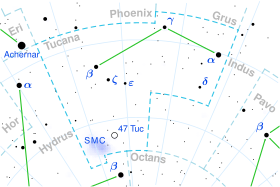| Observation data Epoch J2000 Equinox J2000 | |
|---|---|
| Constellation | Tucana |
| Right ascension | 22h 18m 30.11244s[1] |
| Declination | −60° 15′ 34.6664″[1] |
| Apparent magnitude (V) | 2.86[2] |
| Characteristics | |
| Spectral type | K3 III[3] |
| U−B color index | +1.54[2] |
| B−V color index | +1.39[2] |
| Astrometry | |
| Radial velocity (Rv) | +45.8[4] km/s |
| Proper motion (μ) | RA: −77.000[1] mas/yr Dec.: −32.823[1] mas/yr |
| Parallax (π) | 17.7324 ± 0.3290 mas[1] |
| Distance | 184 ± 3 ly (56 ± 1 pc) |
| Absolute magnitude (MV) | −1.05[5] |
| Absolute bolometric magnitude (Mbol) | −1.97[5] |
| Orbit[6] | |
| Period (P) | 4197.7 days |
| Eccentricity (e) | 0.39 |
| Periastron epoch (T) | 18666.4 |
| Argument of periastron (ω) (secondary) | 48.5° |
| Semi-amplitude (K1) (primary) | 7.2 km/s |
| Details | |
| Mass | 2.5 - 3[7] M☉ |
| Radius | 37[7] R☉ |
| Luminosity | 424[7] L☉ |
| Temperature | 4300[7] K |
| Other designations | |
| Database references | |
| SIMBAD | data |
Alpha Tucanae (α Tuc, α Tucanae) is a binary star system in the southern circumpolar constellation of Tucana. With an apparent visual magnitude of 2.86,[2] it can be seen with the naked eye from the southern hemisphere. Using parallax measurements, the distance to this system can be estimated as 184 light-years (56 parsecs). A cool star with a surface temperature of 4300 K, it is 424 times as luminous as the sun and 37 times its diameter. It is 2.5 to 3 times as massive. It is unclear what stage of evolution the star is in.[7]
This is a spectroscopic binary, which means that the two stars have not been individually resolved using a telescope, but the presence of the companion has been inferred from measuring changes in the spectrum of the primary. The orbital period of the binary system is 4197.7 days (11.5 years).[6] The primary component has a stellar classification of K3 III,[3] which indicates it is a giant star that has exhausted the supply of hydrogen at its core and evolved away from the main sequence. It has the characteristic orange hue of a K-type star.
- ^ a b c d e Vallenari, A.; et al. (Gaia collaboration) (2023). "Gaia Data Release 3. Summary of the content and survey properties". Astronomy and Astrophysics. 674: A1. arXiv:2208.00211. Bibcode:2023A&A...674A...1G. doi:10.1051/0004-6361/202243940. S2CID 244398875. Gaia DR3 record for this source at VizieR.
- ^ a b c d Cite error: The named reference
clpl4was invoked but never defined (see the help page). - ^ a b Cite error: The named reference
houk1978was invoked but never defined (see the help page). - ^ Cite error: The named reference
mnras139_341was invoked but never defined (see the help page). - ^ a b Pasquini, L.; de Medeiros, J. R.; Girardi, L. (2000). "Ca II activity and rotation in F-K evolved stars". Astronomy and Astrophysics. 361: 1011–1022. arXiv:astro-ph/0008109. Bibcode:2000A&A...361.1011P.
- ^ a b Cite error: The named reference
ncsbowas invoked but never defined (see the help page). - ^ a b c d e Kaler, Jim. "Alpha Tucanae". Stars. University of Illinois. Retrieved 19 October 2013.
- ^ Cite error: The named reference
SIMBADwas invoked but never defined (see the help page).
